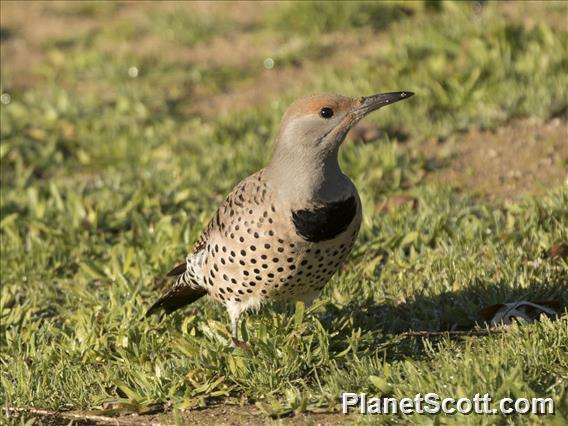Northern Flicker (Colaptes auratus)

Northern Flicker (Colaptes auratus)
×


Northern Flicker (Colaptes auratus)
About Northern Flicker (Colaptes auratus)
- Kingdom: Animals
- Phylum: Chordates
- Class: Birds
- Order: Woodpeckers, Barbets, Toucans, and Puffbirds
- Family: Piculets and Woodpeckers
The northern flicker or common flicker is a medium-sized bird of the woodpecker family. It is native to most of North America, parts of Central America, Cuba, and the Cayman Islands, and is one of the few woodpecker species that migrate. Over 100 common names for the northern flicker are known, including yellowhammer, clape, gaffer woodpecker, harry-wicket, heigh-ho, wake-up, walk-up, wick-up, yarrup, and gawker bird. Many of these names derive from attempts to imitate some of its calls.
Source: Wikipedia
Visits
-
2005-09-15
Elgin, United States of America -
2006-08-15
Canyonlands National Park, United States of America -
2007-01-17
Golden Gate Park - San Francisco Botanical Garden, United States of America -
2007-06-15
Jake's Landing, United States of America -
-
2008-09-20
Emigrant Wilderness, United States of America -
2009-05-05
Elgin - Bluff Spring Fen, United States of America -
2009-05-08
Burnidge Forest Preserve, United States of America -
2009-05-09
Nelson Lake Forest Preserve, United States of America -
2010-01-02
Bidwell Park, United States of America -
2010-06-11
Petersburg - Wrangell Narrows, United States of America -
2010-06-25
Elgin - Bluff Spring Fen, United States of America -
2012-05-20
Pyramid Lake, United States of America -
2012-06-02
Grayling, United States of America -
2012-07-08
Necedah NWR, United States of America -
2012-07-09
Sax-Zim Bog, United States of America -
2012-07-12
Yellowstone National Park, United States of America -
2013-04-21
Alemany Community Garden, United States of America -
-
2013-08-25
Ventana Wilderness, United States of America -
2013-09-28
Presidio - El Polin Spring, United States of America -
-
-
2014-02-16
Golden Gate Park - San Francisco Botanical Garden, United States of America -
-
2014-03-10
San Simeon SP, United States of America -
2014-04-19
Fort Mason, United States of America -
2014-05-09
Cave Creek Canyon--Southwestern Research Station, United States of America -
2014-05-10
Pinery Canyon, United States of America -
2014-06-07
Sunol Regional Wilderness--Visitor Center area, United States of America -
2014-06-14
Peaarson-Arastradero Preserve, United States of America -
-
2014-09-23
Redwood Valley, United States of America -
-
2014-12-28
Glen Canyon Park, United States of America -
2015-01-01
Candlestick Park, United States of America -
2015-01-03
Woodward Park, United States of America -
-
2015-01-19
Lake Merced , United States of America -
-
-
-
-
-
-
-
-
-
-
-
-
-
-
-
-
-
-
-
-
-
-
-
-
-
-
-
-
-
-
-
-
-
-
-
-
-
-
-
-
-
-
-
-
-
-
-
-
-
-
-
-
-
-
-
-
-





